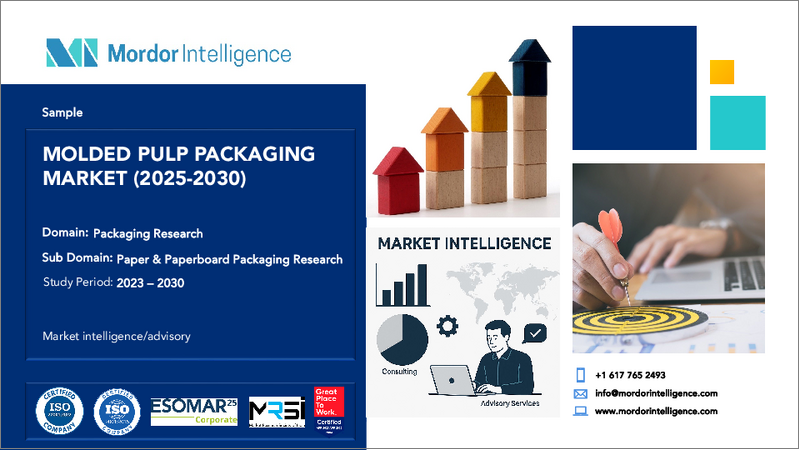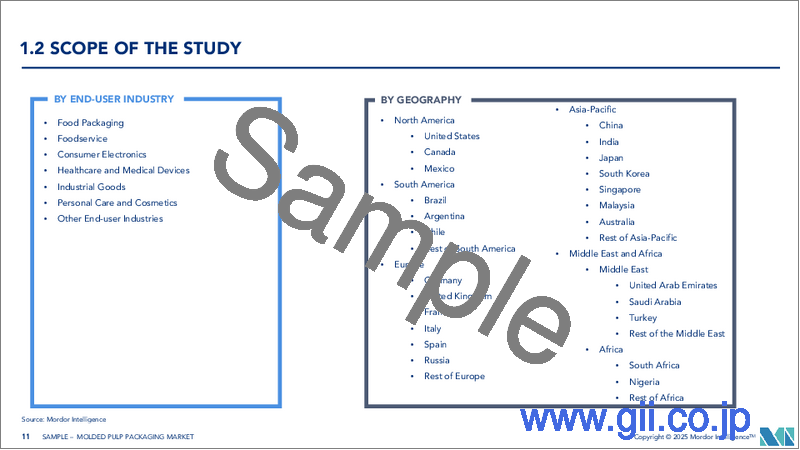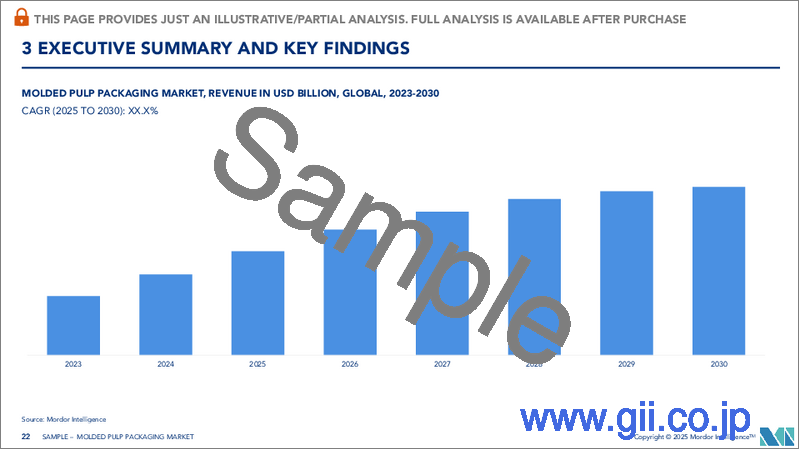|
|
市場調査レポート
商品コード
1689872
成形パルプ包装:市場シェア分析、産業動向・統計、成長予測(2025年~2030年)Molded Pulp Packaging - Market Share Analysis, Industry Trends & Statistics, Growth Forecasts (2025 - 2030) |
||||||
カスタマイズ可能
適宜更新あり
|
|||||||
| 成形パルプ包装:市場シェア分析、産業動向・統計、成長予測(2025年~2030年) |
|
出版日: 2025年03月18日
発行: Mordor Intelligence
ページ情報: 英文 120 Pages
納期: 2~3営業日
|
全表示
- 概要
- 目次
成形パルプ包装の市場規模は2025年に54億9,000万米ドルと推定・予測され、予測期間中(2025~2030年)のCAGRは5.66%で、2030年には72億4,000万米ドルに達すると予測されます。

便利で持続可能な包装代替品への需要が急速に高まっていること、プラスチック代替品として競争力のある繊維成形品の開発が進んでいること、エレクトロニクス、食品包装、ヘルスケア分野からの受注が増加していることなどが、パルプ成形品包装市場の主な促進要因となっています。
主なハイライト
- コンシューマーエレクトロニクスなどのエンドユーザー産業が高い需要を目の当たりにする中、持続可能なパッケージング製品は、輸送用の保護層としてますます使用されるようになっており、保護に役立ち、環境破壊を引き起こさないです。さらに、成形パルプはエンドキャップ、クラムシェル容器、トレイ、皿、ボウルなど複数の製品を作ることができます。
- 様々な経済圏で卵の消費と生産が世界的に拡大していることが、この市場の需要を牽引しています。実際、PrintWeekによると、2030年末には世界の卵消費量は1人当たり10.3kg近くになると予想されています。複数の卵を収納できる丈夫な包装トレイが必要とされ、最終的に成形パルプ包装への道が開かれました。
- 成形パルプ包装は、企業の持続可能性目標に役立つかなりのコスト削減を提供します。成形パルプ包装のコストは、安価で信頼性の高い原材料を使用することで低く抑えられます。プラスチックや発泡スチロールの包装材のほとんどは石油から作られているため、原油価格の変動によって価格が変動します。成形パルプ包装の製造には、広く入手可能で価格も手頃な天然繊維と消費者使用後の紙製品が使用されます。
- 製紙業界では、全繊維の入手可能性が懸念されています。輸入量は300万トンに増加し、数カ国の政府は輸入法や輸入制限を採用し、関税や物品税を引き上げています。最近のコンテナ不足のため、国際定期船会社は価格を引き上げました。40フィートコンテナでの古紙輸送料金は2,800米ドルから3,600米ドルに値上げされました。以前は1,600~1,800米ドル以下でした。
成形パルプ包装市場の動向
食品包装が大きな市場シェアを占める
- 成形パルプ製品は、プラスチックに取って代わり、環境に優しく持続可能な製品に対する需要の高まりに応えるため、食品関連分野でますます使用されるようになっています。食品市場向けの用途には厳しい規格があり、それに準拠する必要があります。食品市場分野の材料には、引張強度や耐熱性といったいくつかの基本的な強度仕様に加え、バリア性の向上が極めて重要です。
- 成形パルプで作られる食品包装製品には、クラムシェルやテイクアウト用ミール容器、卵トレーやカートン、果物、野菜、ベリー、マッシュルームトレーなどがあります。市場に出回っている食品包装の大部分はトレーを利用しています。成型紙パルプ包装は、卵のようなデリケートで壊れやすい商品に最適な保護を提供します。その信頼性により、生産者や小売業者が被る損失や損害は少ないです。卵トレーは保護包装であり、再生新聞を使用して作られています。
- パルプや繊維で成形されたトレーは、卵の包装や保管に不可欠な通気性や吸湿性に優れています。さらに、卵や果物の消費量の増加が見込まれ、軽量でリサイクル可能といった利点もあることから、トレーの需要は増加すると予測されています。鶏卵包装用トレーの需要は大きいです。卵の消費量の増加は、卵トレー包装用の成形パルプの動向を示しています。例えばドイツでは、一人当たりの鶏卵消費量が2021年の14.40キログラムから2023年には14.60キログラムに増加しています。
- 包装には、食品と環境との間のガスや水蒸気の交換を減らし、食品の化学的、物理的、微生物学的変化を遅らせるバリア性が求められます。その結果、食品関連製品の包装を目的とした材料では、水蒸気と酸素に対する透過性が考慮すべき重要な特性です。
著しい成長を遂げるアジア太平洋
- 国連食糧農業機関(FAO)によると、中国は近年世界最大の木材パルプ輸入国となっています。同国では、フードサービス、食品包装、ヘルスケア、FMCG、エレクトロニクスといったエンドユーザー向けのパルプモールドパッケージ製品の需要が伸びています。新興国パルプ包装市場の更なる牽引役となることが期待されます。
- 中国国家開発改革委員会と生態環境部の共同提案は、使い捨て発泡食器、使い捨てプラスチック綿棒の販売、プラスチックビーズを含む日用化学製品の製造を禁止しています。プラスチック禁止・制限が広く実施される新状況の下で、パルプ成型品は環境保護と分解性に優れているため、「プラスチック制限令」後の主な代替品となります。
- 食品と密接に接触するクラムシェル、トレー、カップなどの包装製品の製造にバージンパルプを必要とする外食用ディスポーザブル産業は、ここ数年大きな成長を遂げています。インドでは、外食産業で使用されるバージンパルプのほとんどは、バガスや稲わらなどの非木材由来のものです。Nirmal Bang氏によると、インドの組織化された外食産業は、2025年には2兆3,000億インドルピー(約280億2,000万米ドル)以上の市場規模に達します。
- 持続可能な包装への大幅なシフト、環境に優しい包装ソリューションへの消費者の嗜好、メーカーが製品を包装する方法に対する環境と健康への懸念が、インドの成形パルプ包装市場の成長を促進すると予想されます。
- オンライン食料品ショッピングと生協の食品宅配は、日本で最も重要な2つの食品宅配分野(外部環境や湿気から食品や食料品を保護するために繊維成形包装を使用する)です。しかし、移動の制限や安全性への懸念に対応するために需要が急増したため、外食のフードデリバリー分野は近年大幅に拡大しています。近年はオンライン消費の増加にも変化が見られ、市場の成長を後押しすると期待されています。
成形パルプ包装業界の概要
成形パルプ包装市場は、国内外に複数のプレーヤーが存在するため断片化されています。各社は主に、顧客の要求を満たすためにカスタマイズされたソリューションを提供しています。重要なプレーヤーは、市場での足跡を増やすために、製品の発売、契約、買収など様々な戦略を用いています。市場の主要企業は、Keiding Inc.、EnviroPAK Corporation、Huhtamaki Oyjなどです。
- 2023年11月、フィンランドを拠点とする包装会社Huhtamakiの北米事業部門は、100%リサイクル材料から作られた成形パルプ卵カートンを発売しました。このカートンはインディアナ州ハモンドにあるHuhtamakiの施設で製造されています。
- 2023年6月、Sabert Corporationは、繊維混合成型品の最新製品を発表した:Pulp MaxTMとPulp PlusTMです。これらの環境に優しいパッケージング・ソリューションは、再生紙繊維から作られ、食品用途向けに設計されており、持続可能性の目標に沿い、環境に配慮したパッケージングの選択肢を顧客に提供します。
その他の特典:
- エクセル形式の市場予測(ME)シート
- 3ヶ月間のアナリストサポート
目次
第1章 イントロダクション
- 調査の前提条件と市場定義
- 調査範囲
第2章 調査手法
第3章 エグゼクティブサマリー
第4章 市場洞察
- 市場概要
- 業界の魅力度-ポーターのファイブフォース分析
- 供給企業の交渉力
- 買い手の交渉力
- 新規参入業者の脅威
- 代替品の脅威
- 競争企業間の敵対関係
- 業界の規制と標準
- エコシステム分析
第5章 市場力学
- 市場促進要因
- リサイクル可能で環境に優しい素材に対する消費者の嗜好
- プラスチックやEPS包装に比べてコスト削減のメリットが大きい
- 市場の課題/抑制要因
- 厳しい政府規制
第6章 市場セグメンテーション
- 繊維タイプ別
- リサイクル繊維
- バージン繊維
- 製品タイプ別
- トレー
- ボウル&カップ
- クラムシェル
- 皿
- その他の製品タイプ
- エンドユーザー別
- 食品包装
- フードサービス産業
- 家電製品
- ヘルスケア
- その他エンドユーザー
- 地域別
- 北米
- 米国
- カナダ
- 欧州
- 英国
- ドイツ
- フランス
- アジア
- オーストラリア・ニュージーランド
- 中東・アフリカ
- ラテンアメリカ
- 北米
第7章 競合情勢
- 企業プロファイル
- Maspack Ltd
- Enviropak Corporation
- Brodrene Hartmann AS
- Huhtamaki Oyj
- Primeware Solutions(Amercare Royal)
- UFP Technologies Inc.
- Henry Molded Products Inc.
- Keiding Inc.
- Sabert Corporation
- Pacific Pulp Molding Inc.
- Protopak Engineering Corporation
第8章 投資分析
第9章 市場の将来
The Molded Pulp Packaging Market size is estimated at USD 5.49 billion in 2025, and is expected to reach USD 7.24 billion by 2030, at a CAGR of 5.66% during the forecast period (2025-2030).

Rapidly growing demand for convenient and sustainable packaging alternatives, ongoing development of molded fiber products that are more competitive as a plastic alternative, and increasing orders from electronics, food packaging, and healthcare sectors are some of the primary drivers of the molded pulp packaging market.
Key Highlights
- As end-user industries such as consumer electronics are witnessing high demand, sustainable packaging products are increasingly used as a protective layer for transporting, benefiting in protection and not causing environmental damage. Moreover, the molded pulp can make several products, such as end caps, clamshell containers, trays, plates, and bowls.
- The expanding egg consumption and production in various economies globally drove the demand for the market studied. In fact, according to PrintWeek, the global consumption of eggs is expected to be nearly 10.3 kg/person by the end of 2030. There is a need to have a sturdy packaging tray that can hold multiple eggs, eventually paving the way for molded pulp packaging.
- Molded pulp packaging offers considerable cost savings that can help corporate sustainability goals. Molded pulp packing costs are kept low using inexpensive and reliable raw materials. As most of the plastic and foam packaging is made from petroleum, the price fluctuates according to changes in oil prices. Natural fibers and post-consumer paper products are used to make molded pulp packaging, which is widely available and affordable.
- Total fiber availability is a concern in the paper industry. Imports increased to 3 million tons, and governments of several countries have adopted import laws and restrictions and increased tariffs and excise levies. Due to a recent container shortage, international liners have raised their prices. The rate for transporting waste papers in a 40-foot container has increased from USD 2,800 to USD 3,600. It was formerly under USD 1,600-1,800.
Molded Pulp Packaging Market Trends
Food Packaging to Hold Significant Market Share
- Molded pulp products are increasingly used in the food-related sector to replace plastics and meet the growing demand for eco-friendly and sustainable products. Applications for the food market are subject to strict standards and must comply with them. In addition to some basic strength specifications, such as tensile and thermal qualities, improved barrier properties are crucial for materials in the food market sector.
- The food packaging products made of molded pulp include clam-shell and takeout meal containers, egg trays and cartons, and fruit, vegetable, berry, and mushroom trays. The majority of the food packaging items on the market utilize trays. Molded paper pulp packing offers the best protection for delicate or fragile goods like eggs. Due to its dependability, the producers and retailers suffer fewer losses and damages. Egg trays are protective packaging and are made using recycled newspapers.
- Molded pulp and fiber trays offer good air permeability and hygroscopic ability, which are essential in egg packaging and storage. Moreover, the demand for trays is predicted to rise due to expected increases in egg and fruit consumption, as well as advantages such as low weight and recyclability. The demand for egg packaging trays is significant. The growing consumption of eggs shows the trend of molded pulp for egg tray packaging. For instance, in Germany, per capita consumption of eggs has increased from 14.40 kilograms in 2021 to 14.60 kilograms in 2023.
- The packaging must have barrier qualities that reduce the exchanges of gases and water vapor between the food and the environment to slow down food's chemical, physical, and microbiological changes. As a result, for materials intended for food-related product packaging, the permeability to water vapor and oxygen are crucial properties to consider.
Asia-Pacific to Witness Significant Growth
- China has been the world's largest importer of wood pulp in recent years, according to the Food and Agriculture Organization (FAO). The country is witnessing a growing demand for molded pulp packaged products for end-users, such as food service, food packaging, healthcare, FMCG, and electronics. It is further expected to drive the developed pulp packaging market.
- The joint proposal from the Reform Commission of China's National Development and the Ministry of Ecology and Environment prohibits the sale of disposable foam tableware, disposable plastic cotton swabs, and the production of daily chemical products containing plastic beads. Under the new situation of widespread implementation of the plastic ban and restriction, pulp molded products will become the main substitute after the "plastic restriction order" due to their excellent environmental protection and degradability.
- The food service disposable industry, which demands virgin pulp for manufacturing packaging products, such as clamshells, trays, cups, etc., that come in close contact with food items, has been experiencing substantial growth over the last few years. In India, most virgin pulp used in food service is derived from non-wood sources, such as bagasse and rice straw. According to Nirmal Bang, India's organized food services industry will reach a market value of over INR 2.3 trillion (USD 28.02 billion) in 2025.
- The significant shift to sustainable packaging, consumer preference for eco-friendly packaging solutions, and environmental and health concerns over how manufacturers pack their products are expected to fuel the growth of the molded pulp packaging market in India.
- Online grocery shopping and co-op food deliveries are Japan's two most significant food delivery segments (which use molded fiber packaging to protect food and groceries from external environment and moisture). However, the restaurant food delivery segment has expanded considerably in recent years as demand soared in response to mobility restrictions and safety concerns. The increase in online spending has seen a shift in recent years, which is expected to aid the market's growth.
Molded Pulp Packaging Industry Overview
The molded pulp packaging market is fragmented due to the presence of several domestic and global players. The companies mainly offer customized solutions to meet customer requirements. Significant players use various strategies, such as product launches, agreements, and acquisitions, to increase their footprints in the market. The key players in the market are Keiding Inc., EnviroPAK Corporation, Huhtamaki Oyj, etc.
- In November 2023, The Huhtamaki North America business unit of Finland-based packaging company Huhtamaki launched molded pulp egg cartons made from 100% recycled materials. The cartons are being made at a Huhtamaki facility in Hammond, Indiana.
- In June 2023, Sabert Corporation unveiled its latest offerings in molded fiber blends: Pulp MaxTM and Pulp PlusTM. These eco-friendly packaging solutions are crafted from recycled paper fibers and designed for food applications, aligning with sustainability goals and providing customers with environmentally responsible packaging choices.
Additional Benefits:
- The market estimate (ME) sheet in Excel format
- 3 months of analyst support
TABLE OF CONTENTS
1 INTRODUCTION
- 1.1 Study Assumptions and Market Definition
- 1.2 Scope of the Study
2 RESEARCH METHODOLOGY
3 EXECUTIVE SUMMARY
4 MARKET INSIGHTS
- 4.1 Market Overview
- 4.2 Industry Attractiveness - Porter's Five Forces Analysis
- 4.2.1 Bargaining Power of Suppliers
- 4.2.2 Bargaining Power of Buyers
- 4.2.3 Threat of New Entrants
- 4.2.4 Threat of Substitutes
- 4.2.5 Intensity of Competitive Rivalry
- 4.3 Industry Regulations and Standards
- 4.4 Industry Ecosystem Analysis
5 MARKET DYNAMICS
- 5.1 Market Drivers
- 5.1.1 Consumer Preference Toward Recyclable and Eco-friendly Materials
- 5.1.2 Better Benefit of Cost Saving Compared to Plastic and EPS Packaging
- 5.2 Market Challenges/Restraints
- 5.2.1 Stringent Government Rules and Regulations
6 MARKET SEGMENTATION
- 6.1 By Fiber Type
- 6.1.1 Recycled Fiber
- 6.1.2 Virgin Fiber
- 6.2 By Product Type
- 6.2.1 Trays
- 6.2.2 Bowls and Cups
- 6.2.3 Clamshells
- 6.2.4 Plates
- 6.2.5 Other Product Types
- 6.3 By End User
- 6.3.1 Food Packaging
- 6.3.2 Foodservice
- 6.3.3 Consumer Electronics
- 6.3.4 Healthcare
- 6.3.5 Other End Users
- 6.4 By Geography
- 6.4.1 North America
- 6.4.1.1 United States
- 6.4.1.2 Canada
- 6.4.2 Europe
- 6.4.2.1 United Kingdom
- 6.4.2.2 Germany
- 6.4.2.3 France
- 6.4.3 Asia
- 6.4.4 Australia and New Zealand
- 6.4.5 Middle East and Africa
- 6.4.6 Latin America
- 6.4.1 North America
7 COMPETITIVE LANDSCAPE
- 7.1 Company Profiles
- 7.1.1 Maspack Ltd
- 7.1.2 Enviropak Corporation
- 7.1.3 Brodrene Hartmann AS
- 7.1.4 Huhtamaki Oyj
- 7.1.5 Primeware Solutions (Amercare Royal)
- 7.1.6 UFP Technologies Inc.
- 7.1.7 Henry Molded Products Inc.
- 7.1.8 Keiding Inc.
- 7.1.9 Sabert Corporation
- 7.1.10 Pacific Pulp Molding Inc.
- 7.1.11 Protopak Engineering Corporation





